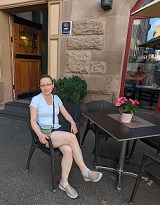Kelley-Morse set theory and choice principles for classes
This is a talk at the SoTFoM II (Symposia on the Foundations of Mathematics) conference in London, UK, January 12-13, 2015.
Slides
Since this talk is similar to the one I gave at the Colloquium Logicum, I will just include here the abstract and links to other posts related to this work.
Abstract: The most common choice principle for classes used in second-order set theory is the choice scheme, which states that if for every set $a$, there is some class $A$ witnessing a given second-order property, then there is a single class coding a witness for the set $a$ on the slice indexed by $a$. The choice scheme is used to show, for instance, that Łoś's Theorem holds for internal second-order ultrapowers and that first-order quantifiers don't affect the second-order complexity of a property. We show that Kelley-Morse set theory (${\rm KM}$), one of the strongest second-order foundations, does not prove the choice scheme even for first-order properties. We also separate some natural fragments of the choice scheme by showing that the set-sized choice scheme, which allows only set many choices, cannot prove the choice scheme for first-order properties, and that the parameterless choice scheme, which does not allow parameters in the definition of a property, cannot prove the choice scheme for $\Pi^1_2$ properties. Finally, we argue that ${\rm KM}^+$, the theory ${\rm KM}$ together with the choice scheme, is a better foundation for second-order set theory than ${\rm KM}$. We show that among the weaknesses of ${\rm KM}$ is that a second-order ultrapower of a ${\rm KM}$ model may not even be a ${\rm KM}$ model and that first-order quantifiers are allowed to affect the second-order complexity of a property. This is joint work with Thomas Johnstone and Joel David Hamkins.
Here are links to other posts related to this work:
